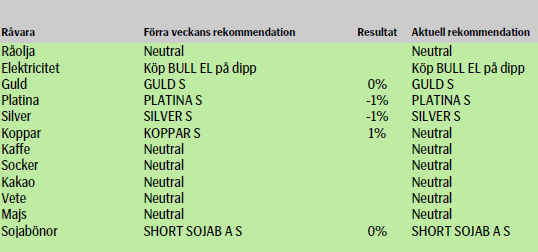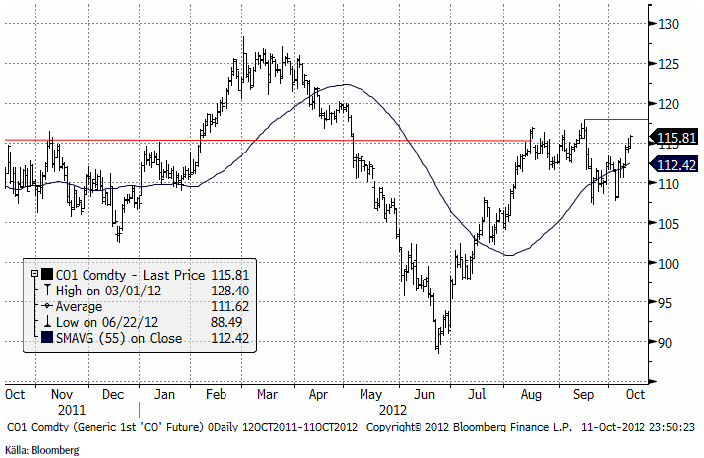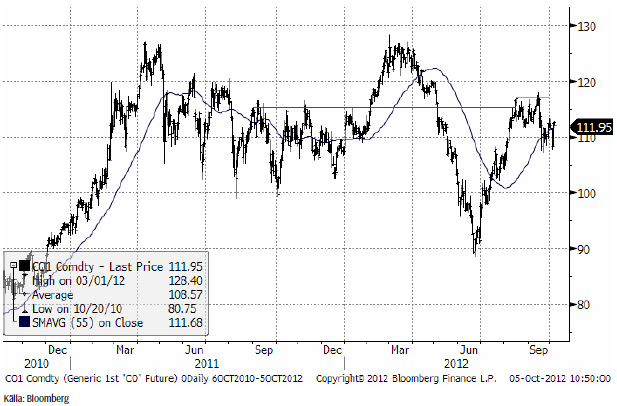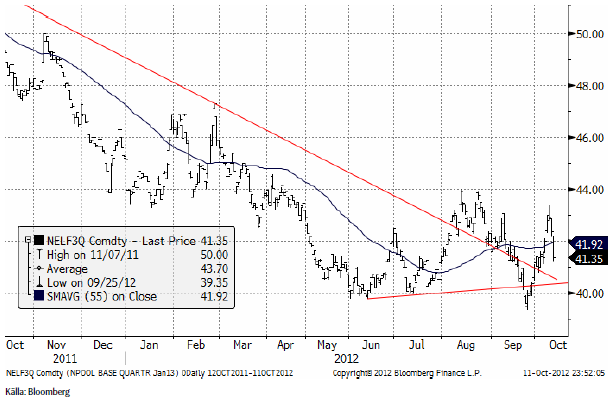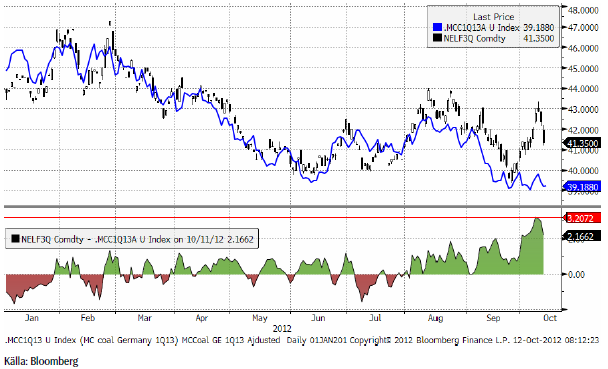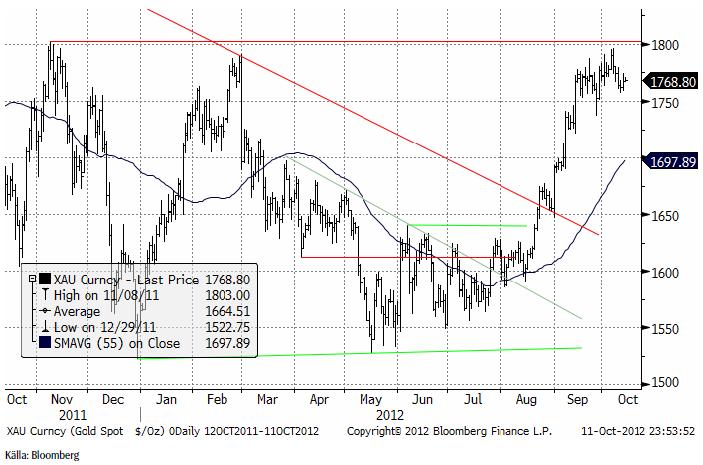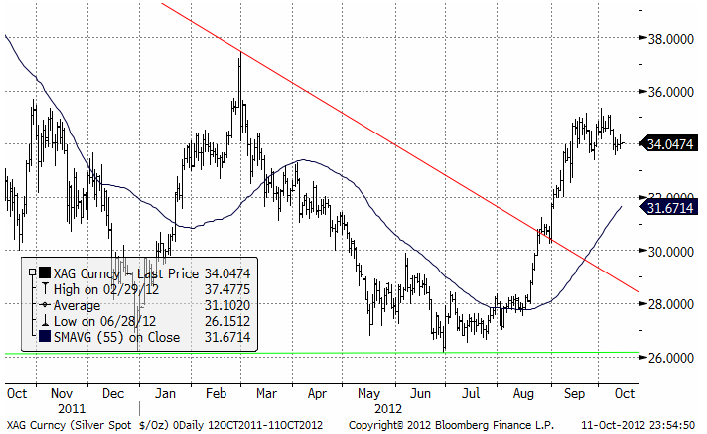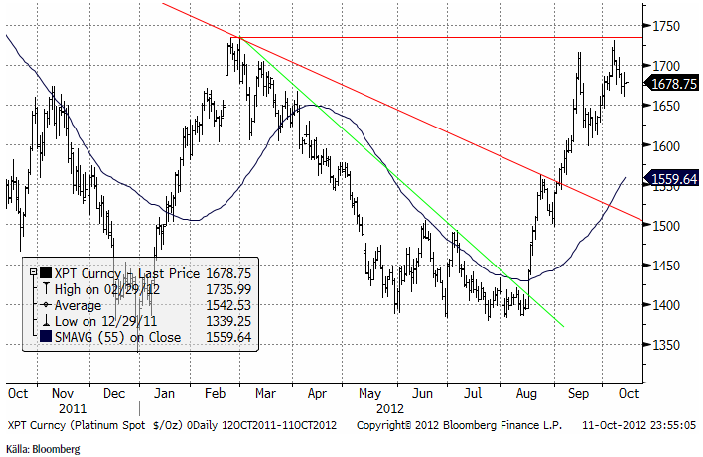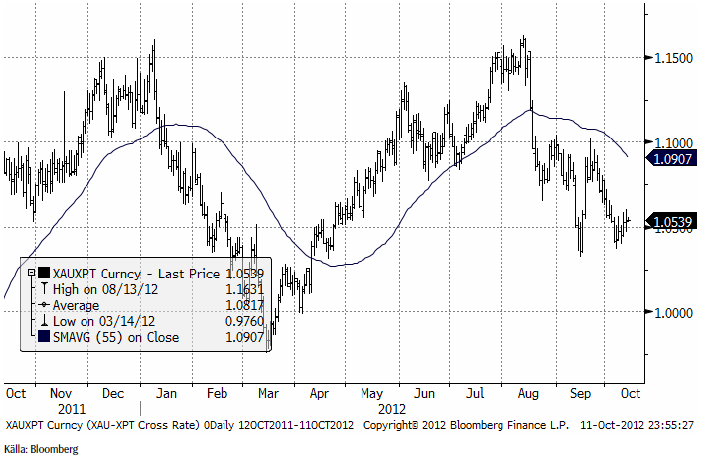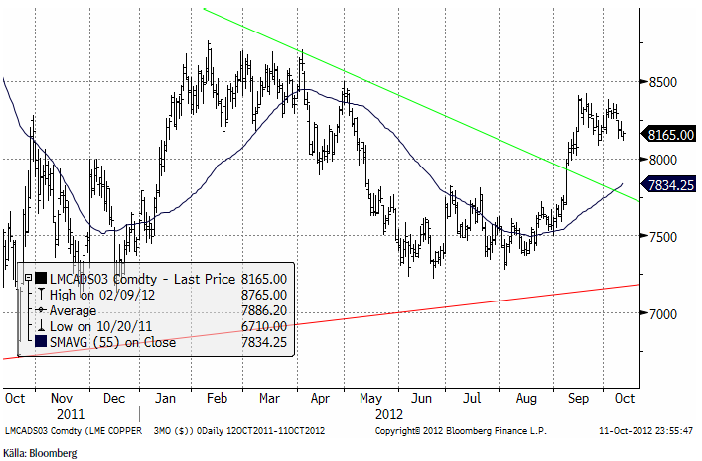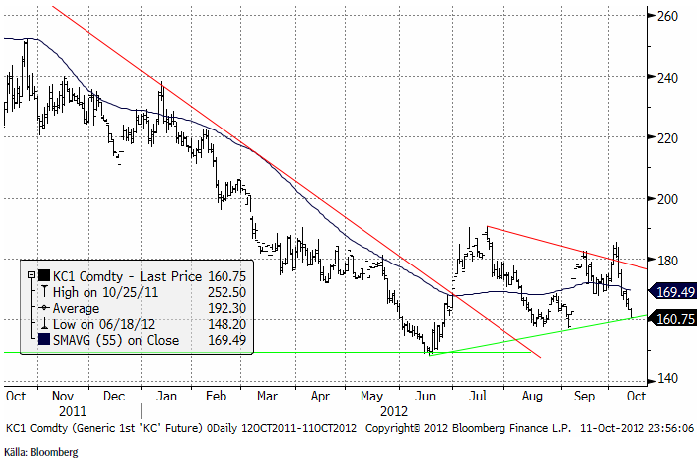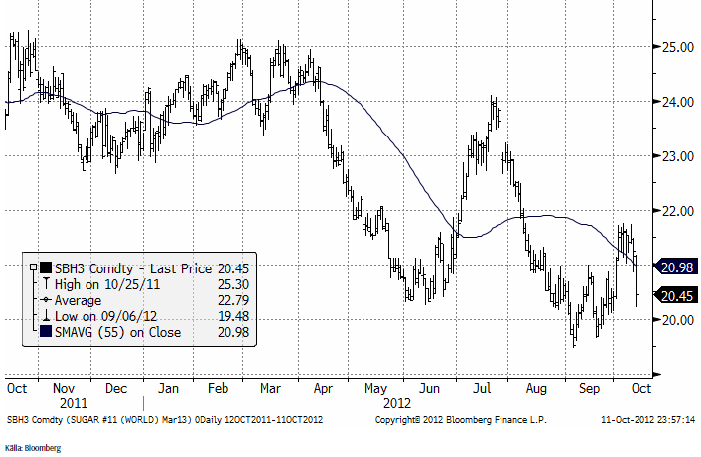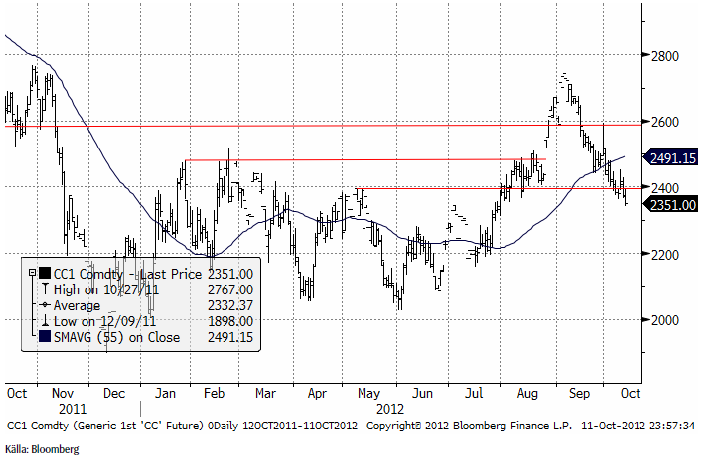Analys
SEB – Råvarukommentarer, 12 oktober 2012
Sammanfattning av rekommendationer
Förra veckans rekommendationer gav en samlad förlust på 1%. Vi väljer att kliva av koppar för närvarande. Såväl ädelmetaller som koppar, handlas inom ett intervall som kan vara en tillfällig topp eller en konsolidering. Om priserna bryter upp är det en signal om ytterligare prisuppgång, och vice versa om priserna faller. Ädelmetaller är långsiktigt på väg uppåt, så vi väljer att ligga kvar på dem. Man kan köpa mer om guld går över 1800 dollar. Platina har ett annat tekniskt mönster. Priset har kommit ner så pass att den är värd att köpa mer av nu.
Elpriset har fallit av ganska kraftigt de senaste dagarna, och om priset faller ner mot 40 euro kan det vara ett köptillfälle för den som vill handla på kort sikt.
Råolja – Brent
Vid en tillbakablick på det tredje kvartalet, så var det för Brent ännu ett turbulent kvartal. Brent handlades till ett snittpris på USD 109,4/fat, USD 0,6/fat under vår prognos. Eftersom flera stora hausse- och baissefaktorer fortfarande är aktuella tvivlar vi på att oljemarknaden kommer att vara speciellt mycket lugnare under det fjärde kvartalet. Vi anser dock USD 110/fat vara en solid utgångspunkt för Brent och diskonterar större makroekonomiska och geopolitiska osäkerheter tämligen väl. Det säkerställer också att kassaflöden förblir tillräckligt starka för att göra välbehövliga investeringar i framtida leveranser. Enligt vårt huvudscenario förväntar vi att Brent, grovt räknat, har ett genomsnitt på USD 110/fat under det fjärde kvartalet i år. Därefter förväntar vi oss ett säsongsmässigt lägre pris på USD 105/fat under det första halvåret nästa år, med återhämtning till USD 115/fat under andra halvan av nästa år, när makroekonomiska förhållanden stabiliseras. Uppenbara nedåtrisker på kort och medellång sikt inbegriper möjligheten att sanktioner kan tvinga Iran tillbaka till förhandlingsbordet, att USA möjligen släpper ut strategiska oljereserver samt oviss efterfrågan från Kina. Nedan ser vi kursdiagrammet för spotkontraktet på Brent.
Priset på Brent-råolja har på sistone pressats upp till över USD 114/fat genom flera haussefaktorer. Extensivt samt väsentligen försenat underhåll i Nordsjön har minskat tillgången på råolja från Nordsjön med förseningar i nästan alla lastningar i oktober. Lastningar i november kommer också att påverkas och de nuvarande förväntningarna är att lastningarna i november kommer att vara de lägsta på 5 år. En annan fysisk drivkraft för Brent-råolja är för närvarande de låga förråden av oljeprodukter av mellandestillat i Europa, kombinerat med så mycket som 2 miljoner fat per dag för raffinaderiunderhåll. Raffineringsmarginalen för mellandestillat är på årshögsta eller flerårshögsta och signalerar knappheten i detta segment. Denna knapphet inträffar under en tid på året när vi fortfarande har en stor del påfyllning framför oss under de kommande månaderna. Lättoljor som t.ex. Brent är den råolja som föredras av raffinaderier när de fysiska marknaderna för lättoljeprodukter eller mellandestillat är strama. Därför stärker den nuvarande knappheten avseende mellandestillat efterfrågan på Brent-råolja.
Framöver kan Mellanöstern- och Nordafrikaregionens geopolitiska påverkan på oljemarknaderna vara både hausse- och baissebetonad. På haussesidan ökas spänningar längs den syrisk-turkiska gränsen med ökad risk för regional smitta och möjlig Natoinblandning. På baissesidan visar Iran tecken på att krokna under trycket från sanktioner. Sprickor börjar visa sig här och var. Snabb inflation ökar den sociala oron, vilket potentiellt skulle kunna tvinga Iran tillbaka till förhandlingsbordet och därmed minska riskerna för oljetillgången.
Flera faktorer på utbudssidan har mildrats; Det verkar som sanktionerna mot Iran börjar ge resultat. Regimen pressas sedan tidigare av uteblivna intäkter från oljeexport. I september exporterades 1.15 miljoner fat/dag jämfört med 2.4 miljoner fat/dag i genomsnitt förra året. Nu har dessutom uppvärmningssäsongen inletts. Iran har, trots att man är stor nettoexportör av råolja, inte tillräcklig raffinaderikapacitet för att förse den inhemska marknaden med oljeprodukter som bensin, diesel och olja för uppvärmning. Istället måste man köpa dessa produkter på den internationella marknaden – till höga priser (bland annat p g a sanktionerna). Att den egna valutan dessutom urholkats i värde gör inte saken bättre. Höga matpriser har redan drivit upp inflationen och nu är situationen än värre. Trycket på regimen är så stort, att chansen för att man återgår till förhandlingar med USA och EU, är bättre än på länge.
I september var rekordstor kapacitet i Nordsjön borta från marknaden p g a underhåll och reparationer. Många av dessa arbeten är försenade men vi räknar ändå med att utbudet snart ökar, vilket bör mildra pressen uppåt på olja. Vi har också passerat den säsongsmässiga toppen på orkansäsongen utan några allvarliga implikationer på oljemarknaden (med undantag för Isaac som kortsiktigt störde produktion och distribution i mexikanska gulfen).
Trots ovanstående argument för nedsidan, så ser vi värde kring Brentpris kring nivåer där priset tidigare vänt åter upp (kring 107-108 usd). Detta då den geopolitiska situationen i Iran och Syrien m fl länder fortsatt verkar för en premie på oljepriset. I skrivande stund handlas kontraktet på 110.20, där vår rekommendation, förblir neutral.
Elektricitet
Nedan ser vi priset på första kvartalskontraket 2013 på el, som är underliggande för våra certifikat. Priset har rekylerat kraftigt de senaste dagarna.
Vi har tidigare kommunicerat att 40-nivån på Q1-13 terminen (den termin som våra certifikat replikerar) är en attraktiv ingångsnivå för en long position. Vi håller fast vid detta, då nedsidan därifrån bör vara begränsad, detta för att:
- CO2 priset: Uppside potential på förhoppningar om politisk intervention i CO2 marknaden
- Kolpriset: Har planat ut och nedsidan är begränsad.
- Prispremien för problem med kärnkraft- och för köldknäppar i vinter ger stöd for Q1-13
Kontraktet handlas nu på 41,3 efter att det nyligen tradat upp till €43.35/MWh driven av signaler på torrare och kallare väder. Däremot har inte uppgången varit förankrad i en annan viktig prisdrivare, marginalkostnaden för koleldad kraftproduktion, se grafen nedan.
I den nedre delen i diagrammet ovan, ser vi hur differensen mellan Q1-13 (NELF3Q Comdty) och vårt kontinentala index for marginalkostnader drivits upp till en nivå där den tidigare fallit tillbaka. Den 8 oktober var differensen uppe i €3.2/MWh. Den här differensen har nu korrigerats till mer normala nivåer. Det är fortsatt mycket god tillgång på vatten i det nordiska kraftsystemet. Magasinen är fulla och den hydrologiska balansen är på ca +12 TWh. För en rejäl uppgång behöver kontraktet stöd av både väder och marginalkostnader.
Det ser ut som om marknaden kan ge en ny möjlighet att köpa Q1-13 på nivåer nära €40/MWh. En sådan position, t ex genom köp av BULL EL X4 S, ger en position med begränsad nedsida samtidigt som det ger möjlighet till prisuppgångar från chansen att något av följande faktorer slår in: risken för kallare och torrare väder, kärnkraftproblem, CO2 interventionsoptimism samt en möjlig uppgång i kolpriset under början av vintern, som står for dörren.
Guld och Silver
Konsolideringen har fortsatt under veckan, fortsatt utan genombrott. Förra veckan testade marknaden nästan $1800-nivån, men fallerade och handlas nu mitt i intervallet kring $1770. Vi kvarstår med bedömningen att behålla guldet om man redan har köpt, och öka eller köpa nytt vid ett genombrott av $1800. Nedan ser vi kursdiagrammet för guld i dollar per troy ounce.
Nedan ser vi kursdiagrammet för silver i dollar per troy ounce.
Platina
Platina har fallit tillbaka med övriga metaller, men uppvisar en mer positiv trend. Veckans rekyl bedömer vi som ett bra köptillfälle.
Vi tror på ädelmetaller som placering i nuvarande makromiljö. Den oroliga utvecklingen i Sydafrika har redan påverkat utbudet märkbart. Vi tror att platina priset kommer att utmana igen och återgå till ”normaltillståndet”, d.v.s. att vara dyrare än guld.
Nedan ser vi priset på guld dividerat med priset på platina. Vi väntar oss att platina ska fortsätta vinna på guldet.
Koppar
Veckan inleddes med ett prisfall på 1-1,5 % när kineserna kom tillbaka på säljsidan, efter en veckas ledighet (Golden week). Samtidigt hade USA stängt i måndags (Columbus day) så likviditeten var begränsad. IMF reviderade ner prognosen för den globala tillväxten till 3,3 % 2012 och en långsam återhämtning till 3,6 % nästa år. De tror dock på en relativt stark kinesisk tillväxt på 7,8 % och 8,2 % nästa år. Eurogruppens möte skapade oro i måndags, men beskeden på tisdag morgon, att den permanenta räddningsfonden (ESM) formellt godkändes, fick stämningsläget på världens finansmarknader att stabiliseras – och så även metallerna. Sett över hela veckan är det ändå relativt kraftigt nedåt, mellan 4 och 5 %. Sämst gick det för aluminium som föll efter Alcoas resultatrapport, där bolaget reviderade ner sin globala efterfrågetillväxtprognos för 2012 från 7 till 6 %. Koppar är den ”lysande stjärnan” med endast en marginell nedgång under procenten (se nedan).
Koppar
Vi har tidigare varnat för effekten efter stimulanspaketen, måste följas upp av industriell efterfrågan. Det har inte riktigt materialiserats, och priserna faller tillbaka. Vi är nu i början av det säsongsmässigt starkaste kvartalet, så en förbättring bör skönjas de närmsta veckorna. Jämfört med övriga basmetaller så håller koppar väldigt bra. Som vi nämnt tidigare är kopparmarknaden i grunden fundamentalt stark. International Copper Study Group (ICSG) redovisade en rapport gällande balansen mellan utbud och efterfrågan. För 2012 bekräftas den strama marknaden och de bedömer ett underskott om ca 400 tton, och det är tight med tanke på ett synligt lager börslager på LME om 220 tton. Det är naturligtvis inte allt, men en stor del av det som finns utanför Kina. Rykten gör gällande att minst 600 000 ton ligger i kinesiska frihamnslager. I vilket fall som helst så betyder underskottet en teoretisk lagerminskning på 400 000 ton. Risken finns därför att det kortsiktigt blir väldigt ont om koppar utanför Kina. För att det kinesiska lagret ”ska börja röra på sig” dvs skeppas från Kina, krävs sannolikt ett högre kopparpris på LME. Koppar är köpvärd.
Vi väljer att på kort sikt rekommendera en lång position i koppar.
Kaffe
Kaffepriset har fortsatt att fall i pris och ligger nu precis på dubbla stöd. Dels stödlinjen mellan bottnarna som är inritad som grön linje i diagrammet nedan, dels stödet i och med den jämna prisnivån 160 cent per pund. Sälj på brott nedåt av stödet. Annars kan den flinke försöka köpa med en stop-loss strax under stödet.
Socker
Nedan ser vi priset för leverans i mars nästa år. Trots ett starkt stöd vid 20 cent, ser vi tydligt att den långsiktiga trenden är nedåtriktad.
Kakao
Kakaopriset är nere en nivå där det borde finnas stöd.
Vi väljer att vara neutrala i kakao till nästa vecka.
För spannmål och övriga jordbruksprodukter hänvisas till gårdagens nyhetsbrev om jordruksprodukter.
[box]SEB Veckobrev Veckans råvarukommentar är producerat av SEB Merchant Banking och publiceras i samarbete och med tillstånd på Råvarumarknaden.se[/box]
Disclaimer
The information in this document has been compiled by SEB Merchant Banking, a division within Skandinaviska Enskilda Banken AB (publ) (“SEB”).
Opinions contained in this report represent the bank’s present opinion only and are subject to change without notice. All information contained in this report has been compiled in good faith from sources believed to be reliable. However, no representation or warranty, expressed or implied, is made with respect to the completeness or accuracy of its contents and the information is not to be relied upon as authoritative. Anyone considering taking actions based upon the content of this document is urged to base his or her investment decisions upon such investigations as he or she deems necessary. This document is being provided as information only, and no specific actions are being solicited as a result of it; to the extent permitted by law, no liability whatsoever is accepted for any direct or consequential loss arising from use of this document or its contents.
About SEB
SEB is a public company incorporated in Stockholm, Sweden, with limited liability. It is a participant at major Nordic and other European Regulated Markets and Multilateral Trading Facilities (as well as some non-European equivalent markets) for trading in financial instruments, such as markets operated by NASDAQ OMX, NYSE Euronext, London Stock Exchange, Deutsche Börse, Swiss Exchanges, Turquoise and Chi-X. SEB is authorized and regulated by Finansinspektionen in Sweden; it is authorized and subject to limited regulation by the Financial Services Authority for the conduct of designated investment business in the UK, and is subject to the provisions of relevant regulators in all other jurisdictions where SEB conducts operations. SEB Merchant Banking. All rights reserved.
Analys
Sell the rally. Trump has become predictable in his unpredictability

Hesitant today. Brent jumped to an intraday high of $66.36/b yesterday after having touched an intraday low of $60.07/b on Monday as Indian and Chinese buyers cancelled some Russian oil purchases and instead redirected their purchases towards the Middle East due to the news US sanctions. Brent is falling back 0.4% this morning to $65.8/b.

It’s our strong view that the only sensible thing is to sell this rally. In all Trump’s unpredictability he has become increasingly predictable. Again and again he has rumbled about how he is going to be tough on Putin. Punish Putin if he won’t agree to peace in Ukraine. Recent rumbling was about the Tomahawk rockets which Trump threatened on 10 October and 12 October to sell/send to Ukraine. Then on 17 October he said that ”the U.S. didn’t want to give away weapons (Tomahawks) it needs”.
All of Trump’s threats towards Putin have been hot air. So far Trump’s threats have been all hot air and threats which later have evaporated after ”great talks with Putin”. After all these repetitions it is very hard to believe that this time will be any different. The new sanctions won’t take effect before 21. November. Trump has already said that: ”he was hoping that these new sanctions would be very short-lived in any case”. Come 21. November these new sanctions will either evaporate like all the other threats Trump has thrown at Putin before fading them. Or the sanctions will be postponed by another 4 weeks or 8 weeks with the appearance that Trump is even more angry with Putin. But so far Trump has done nothing that hurt Putin/Russia. We can’t imagine that this will be different. The only way forward in our view for a propre lasting peace in Ukraine is to turn Ukraine into defensive porcupine equipped with a stinging tail if need be.
China will likely stand up to Trump if new sanctions really materialize on 21 Nov. Just one country has really stood up to Trump in his tariff trade war this year: China. China has come of age and strength. I will no longer be bullied. Trump upped tariffs. China responded in kind. Trump cut China off from high-end computer chips. China put on the breaks on rare earth metals. China won’t be bullied any more and it has the power to stand up. Some Chinese state-owned companies like Sinopec have cancelled some of their Russian purchases. But China’s Foreign Ministry spokesperson Guo Jiakun has stated that China “oppose unilateral sanctions which lack a basis in international law and authorization of the UN Security Council”. Thus no one, not even the US shall unilaterally dictate China from whom they can buy oil or not. This is yet another opportunity for China to show its new strength and stand up to Trump in a show of force. Exactly how China choses to play this remains to be seen. But China won’t be bullied by over something as important as its oil purchases. So best guess here is that China will defy Trump on this. But probably China won’t need to make a bid deal over this. Firstly because these new sanctions will either evaporate as all the other threats or be postponed once we get to 21 November. Secondly because the sanctions are explicit towards US persons and companies but only ”may” be enforced versus non-US entities.
Sanctions is not a reduction in global supply of oil. Just some added layer of friction. Anyhow, the new sanctions won’t reduce the supply of Russian crude oil to the market. It will only increase the friction in the market with yet more need for the shadow fleet and ship to ship transfer of Russian oil to dodge the sanctions. If they materialize at all.
The jump in crude oil prices is probably due to redirections of crude purchases to the Mid-East and not because all speculators are now turned bullish. Has oil rallied because all speculators now suddenly have turned bullish? We don’t think so. Brent crude has probably jumped because some Indian and Chinese oil purchasers of have redirected their purchases from Russia towards the Mid-East just in case the sanctions really materializes on 21 November.
Analys
Brent crude set to dip its feet into the high $50ies/b this week

Parts of the Brent crude curve dipping into the high $50ies/b. Brent crude fell 2.3% over the week to Friday. It closed the week at $61.29/b, a slight gain on the day, but also traded to a low of $60.14/b that same day and just barely avoided trading into the $50ies/b. This morning it is risk-on in equities which seems to help industrial metals a little higher. But no such luck for oil. It is down 0.8% at $60.8/b. This week looks set for Brent crude to dip its feet in the $50ies/b. The Brent 3mth contract actually traded into the high $50ies/b on Friday.

The front-end backwardation has been on a weakening foot and is now about to fully disappear. The lowest point of the crude oil curve has also moved steadily lower and lower and its discount to the 5yr contract is now $6.8/b. A solid contango. The Brent 3mth contract did actually dip into the $50ies/b intraday on Friday when it traded to a low point of $59.93/b.
More weakness to come as lots of oil at sea comes to ports. Mid-East OPEC countries have boosted exports along with lower post summer consumption and higher production. The result is highly visibly in oil at sea which increased by 17 mb to 1,311 mb over the week to Sunday. Up 185 mb since mid-August. On its way to discharge at a port somewhere over the coming month or two.
Don’t forget that the oil market path ahead is all down to OPEC+. Remember that what is playing out in the oil market now is all by design by OPEC+. The group has decided that the unwind of the voluntary cuts is what it wants to do. In a combination of meeting demand from consumers as well as taking back market share. But we need to remember that how this plays out going forward is all at the mercy of what OPEC+ decides to do. It will halt the unwinding at some point. It will revert to cuts instead of unwind at some point.
A few months with Brent at $55/b and 40-50 US shale oil rigs kicked out may be what is needed. We think OPEC+ needs to see the exit of another 40-50 drilling rigs in the US shale oil patches to set US shale oil production on a path to of a 1 mb/d year on year decline Dec-25 to Dec-26. We are not there yet. But a 2-3 months period with Brent crude averaging $55/b would probably do it.
Oil on water increased 17 mb over the week to Sunday while oil in transit increased by 23 mb. So less oil was standing still. More was moving.

Crude oil floating storage (stationary more than 7 days). Down 11 mb over week to Sunday

The lowest point of the Brent crude oil curve versus the 5yr contract. Weakest so far this year.

Crude oil 1mth to 3mth time-spreads. Dubai held out strongly through summer, but then that center of strength fell apart in late September and has been leading weakness in crude curves lower since then.

Analys
Crude oil soon coming to a port near you

Rebounding along with most markets. But concerns over solidity of Gaza peace may also contribute. Brent crude fell 0.8% yesterday to $61.91/b and its lowest close since May this year. This morning it is bouncing up 0.9% to $62.5/b along with a softer USD amid positive sentiment with both equities and industrial metals moving higher. Concerns that the peace in Gaza may be less solid than what one might hope for also yields some support to Brent. Bets on tech stocks are rebounding, defying fears of trade war. Money moving back into markets. Gold continues upwards its strong trend and a softer dollar helps it higher today as well.

US crude & products probably rose 5.6 mb last week (API) versus a normal seasonal decline of 2.4 mb. The US API last night partial and thus indicative data for US oil inventories. Their data indicates that US crude stocks rose 7.4 mb last week, gasoline stocks rose 3.0 mb while Distillate stocks fell 4.8 mb. Altogether an increase in commercial crude and product stocks of 5.6 mb. Commercial US crude and product stocks normally decline by 2.4 mb this time of year. So seasonally adjusted the US inventories rose 8 mb last week according to the indicative numbers by the API. That is a lot. Also, the counter seasonal trend of rising stocks versus normally declining stocks this time of year looks on a solid pace of continuation. If the API is correct then total US crude and product stocks would stand 41 mb higher than one year ago and 6 mb higher than the 2015-19 average. And if we combine this with our knowledge of a sharp increase in production and exports by OPEC(+) and a large increase in oil at sea, then the current trend in US oil inventories looks set to continue. So higher stocks and lower crude oil prices until OPEC(+) switch to cuts. Actual US oil inventory data today at 18:00 CET.
US commercial crude and product stocks rising to 1293 mb in week 41 if last nights indicative numbers from API are correct.

Crude oil soon coming to a port near you. OPEC has lifted production sharply higher this autumn. At the same time demand for oil in the Middle-East has fallen as we have moved out of summer heat and crude oil burn for power for air-conditioning. The Middle-East oil producers have thus been able to lift exports higher on both accounts. Crude oil and condensates on water has shot up by 177 mb since mid-August. This oil is now on its way to ports around the world. And when they arrive, it will likely help to lift stocks onshore higher. That is probably when we will lose the last bit of front-end backwardation the the crude oil curves. That will help to drive the front-month Brent crude oil price down to the $60/b line and revisit the high $50ies/b. Then the eyes will be all back on OPEC+ when they meet in early November and then again in early December.
Crude oil and condensates at sea have moved straight up by 177 mb since mid-August as OPEC(+) has produced more, consumed less and exported more.

-

 Nyheter4 veckor sedan
Nyheter4 veckor sedanOPEC+ missar produktionsmål, stöder oljepriserna
-

 Nyheter3 veckor sedan
Nyheter3 veckor sedanGoldman Sachs höjer prognosen för guld, tror priset når 4900 USD
-

 Nyheter4 veckor sedan
Nyheter4 veckor sedanBlykalla och amerikanska Oklo inleder ett samarbete
-

 Nyheter3 veckor sedan
Nyheter3 veckor sedanGuld nära 4000 USD och silver 50 USD, därför kan de fortsätta stiga
-
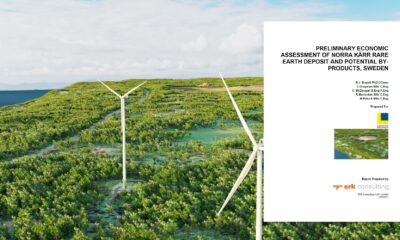
 Nyheter2 veckor sedan
Nyheter2 veckor sedanLeading Edge Materials är på rätt plats i rätt tid
-

 Nyheter3 veckor sedan
Nyheter3 veckor sedanNytt prisrekord, guld stiger över 4000 USD
-

 Nyheter4 veckor sedan
Nyheter4 veckor sedanEtt samtal om guld, olja, koppar och stål
-

 Analys4 veckor sedan
Analys4 veckor sedanOPEC+ will likely unwind 500 kb/d of voluntary quotas in October. But a full unwind of 1.5 mb/d in one go could be in the cards



